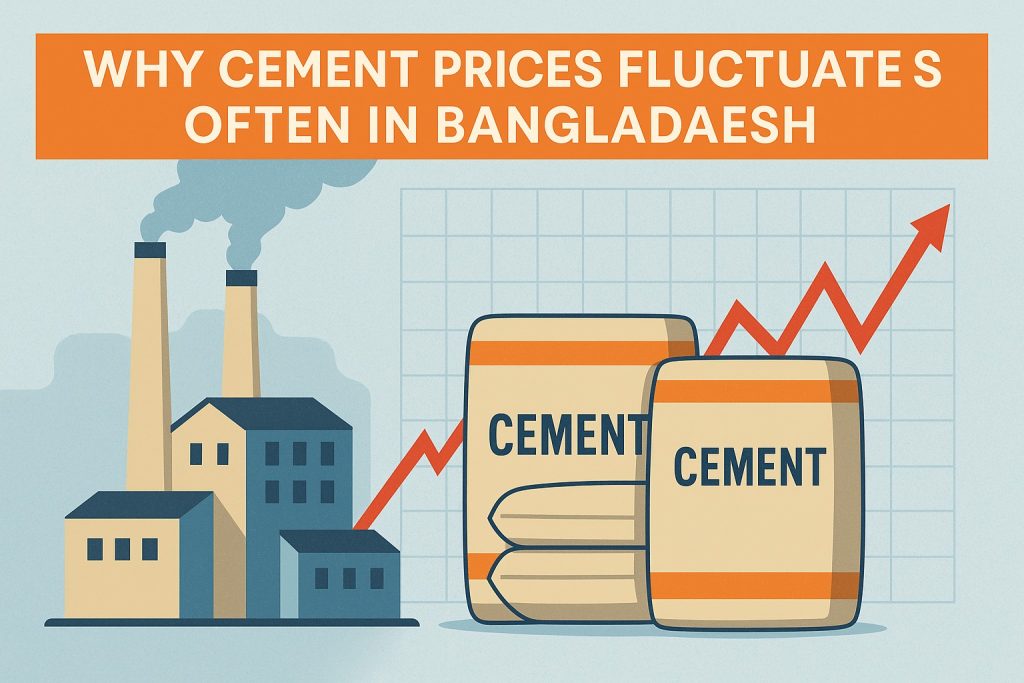Cement is the silent foundation beneath Bangladesh’s booming skyline—from Dhaka’s high-rises to village homes. Yet anyone involved in construction knows that cement prices here never stay still. They rise, fall, and rise again, often within weeks. Understanding why cement prices fluctuate so often helps builders, retailers, and homeowners plan better and stay competitive in a rapidly developing market.
Cement Prices Fluctuate so Often in Bangladesh
Cement is more than just a building material—it’s a symbol of Bangladesh’s transformation from a developing nation to an emerging industrial powerhouse. From modern expressways and metro rails to rural housing projects, the demand for cement touches nearly every corner of the country.

Over the years, this vital sector has fueled economic expansion, job creation, and infrastructural progress. However, behind this progress lies a volatile market, where prices rise and fall due to complex economic, logistical, and environmental factors. Understanding these underlying forces is essential to grasp the true story of Bangladesh’s construction-driven economy
1. The Backbone of Bangladesh’s Growth
Cement demand in Bangladesh has surged over the past two decades as urbanization, infrastructure expansion, and private real-estate investment accelerated. With mega-projects such as the Padma Bridge, Dhaka Metro Rail, and Rooppur Nuclear Plant, annual consumption now exceeds 40 million tons. But high demand does not mean stable prices—the cement industry is extremely sensitive to external shocks, both local and global.
2. Why Do Cement Prices Fluctuate So Frequently?
For many people outside the construction industry, it’s easy to assume cement prices should remain steady—after all, it’s a basic material produced locally. But in reality, the cement industry is one of the most cost-sensitive sectors in Bangladesh, where even the smallest shifts in global trade, logistics, or fuel prices ripple across the entire supply chain.
Cement doesn’t exist in isolation; it sits at the intersection of international trade, energy, transportation, and government policy. Most of its raw materials and different types of cement materials raw materials high demand—especially clinker, coal, and gypsum—are imported, making the industry highly vulnerable to currency depreciation, port delays, and freight rate hikes. At the same time, domestic factors such as energy shortages, seasonal construction cycles, and regional transportation costs add further instability.
As a result, a bag of cement that costs Tk 500 today might jump to Tk 530 next month and then fall again, depending on how global and local forces interact. These constant fluctuations create challenges not only for builders and retailers but also for large infrastructure projects that depend on cost predictability.
Understanding these dynamics helps explain why Bangladesh’s cement prices are rarely constant for long. Below are the key factors that drive these frequent price changes across the country.
A. Volatile Raw Material Costs
Cement production relies on four main raw materials:
- Clinker – the key ingredient (mostly imported from Vietnam, Indonesia, and the Middle East)
- Limestone – limited local availability
- Gypsum – used to control setting time
- Fly ash and slag – industrial by-products
Because Bangladesh imports more than 85 % of its clinker, global price shifts directly hit local manufacturers. When international clinker or coal prices rise, producers adjust local retail prices within days. Even a $5 increase per ton of clinker can push retail cement up by Tk 20 – 30 per bag.
B. Fuel and Energy Prices
Cement factories are energy-intensive. Rising gas, diesel, and electricity costs increase production and transportation expenses. For example:
- When diesel prices jumped by 34 % in 2022, delivery charges for a single truckload of cement rose by almost Tk 2,000.
- Frequent gas supply disruptions force plants to rely on costly alternatives, further inflating per-bag costs.
C. Transportation and Logistics Disruptions
Bangladesh’s logistics depend heavily on river routes and road freight. Monsoon flooding, port congestion, or fuel price hikes immediately affect transportation costs. In many regions—especially Chattogram, Sylhet, and Rajshahi—transport is the single largest cost component after clinker.
A temporary strike, container shortage, or increase in toll rates can cause prices to fluctuate overnight.
D. Currency Exchange Rates
Because the cement sector is import-dependent, the Bangladeshi taka’s devaluation against the USD has a major impact. When the taka weakened by nearly 20 % in 2023, import bills for clinker, coal, and packaging materials surged. Manufacturers had no choice but to adjust prices upward to protect margins.
E. Government Taxes and Duties
The National Budget often changes import duties, VAT, or supplementary taxes. Even a 1 % increase in VAT on clinker or cement bags can translate to a Tk 10–15 price rise. Conversely, temporary tax relief or subsidies may lower prices—but these are rare and short-lived.
F. Market Competition and Brand Positioning
Bangladesh hosts over 40 active cement brands, including large groups such as Shah Cement, LafargeHolcim, Crown, Premier, and Charu Ceramic Industries Ltd. (COTTO Cement Line).
When one or two big players lower prices to boost market share, others follow. Seasonal promotions, dealer incentives, and retail discounts can make prices appear unstable even when production costs stay constant.
G. Seasonal Demand Patterns
Cement demand peaks during dry seasons (November–April) and drops sharply during monsoon months. The construction slowdown in heavy rain forces producers to offer discounts, while the dry-season building rush pushes prices up again. This cyclical pattern repeats every year.
H. Geopolitical Tensions and Global Trade Disruptions
The global supply chain still feels the aftershocks of the Russia-Ukraine conflict and Red Sea shipping issues. Shortages of coal, higher freight rates, and port delays have periodically increased clinker costs, causing local price volatility. Even minor global disruptions ripple through Bangladesh’s import-driven cement market.
3. Regional Price Differences Within Bangladesh
Cement is locally manufactured but regionally priced.
Several factors explain why:
- Proximity to ports: Chattogram enjoys lower freight and import costs.
- Transportation distance: Northern and southwestern districts (Rajshahi, Jessore, Bogura) face higher truck freight.
- Dealer network strength: Brands with strong rural distributors can offer competitive rates.
- Local demand: Urban centers consume more cement, creating pricing flexibility.
Thus, a 50-kg bag may cost Tk 510 in Chattogram but Tk 540–550 in Rangpur or Sylhet—a difference that illustrates Bangladesh’s uneven logistics.
4. How Economic Uncertainty Amplifies Price Swings
Macroeconomic instability—like inflation or foreign reserve shortages—magnifies price fluctuations. When importers face delays in opening LCs (letters of credit), clinker shipments slow, creating artificial shortages. Distributors then hike retail prices in anticipation of stockouts.
This “expectation-driven inflation” often worsens the situation, even if raw material prices later stabilize.
5. The Role of Government and Industry Regulation
The Bangladesh Cement Manufacturers Association (BCMA) regularly negotiates with the government for smoother import policy and stable energy supply. Periodic meetings with the National Board of Revenue (NBR) aim to adjust duties and ensure fair competition.
Government monitoring helps prevent unethical price cartels, yet without long-term energy and infrastructure stability, price volatility will remain an ongoing challenge.
6. What Can Stabilize Cement Prices?
While short-term fluctuations are inevitable, several strategies can reduce volatility:
- Local clinker production: Expanding integrated plants (like Lafarge Surma Cement in Sylhet) lowers import dependency.
- Alternative fuels: Using waste heat recovery and renewable energy reduces reliance on expensive fossil fuels.
- Better transport infrastructure: Improved roads, bridges, and river ports cut logistics costs.
- Currency management: Maintaining exchange-rate stability helps importers forecast costs.
- Policy consistency: Predictable tax and duty structures encourage price discipline.
If these measures align, Bangladesh could achieve more sustainable pricing, benefiting both industry and consumers.
7. Consumer Awareness and Buying Tips
Homeowners and contractors can minimize risk from price swings:
- Plan ahead: Buy cement in bulk during off-peak seasons.
- Compare brands: Sometimes smaller brands offer similar quality at lower cost.
- Track market updates: Check weekly cement price reports and industry news.
- Negotiate with dealers: Retailers often offer discounts on advance bookings.
- Choose quality over price: Poor-grade cement can lead to costly repairs later.
Final Thoughts
Cement prices in Bangladesh reflect a complex mix of global supply chains, local infrastructure, currency rates, and seasonal demand. While temporary reliefs appear from time to time, true stability will depend on long-term policy consistency, energy diversification, and local production capacity.
For now, stakeholders must stay informed, plan strategically, and adapt to an industry where change is the only constant.


